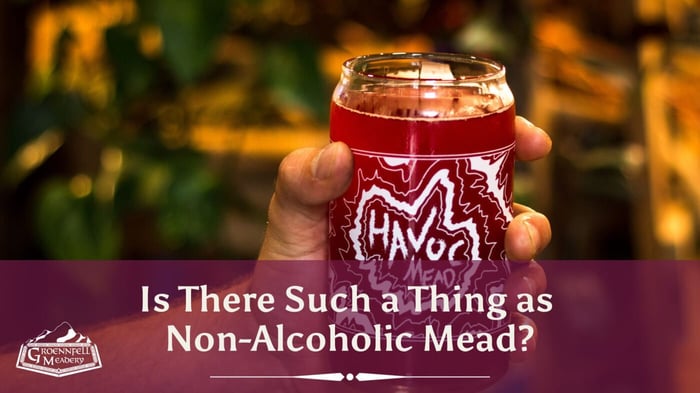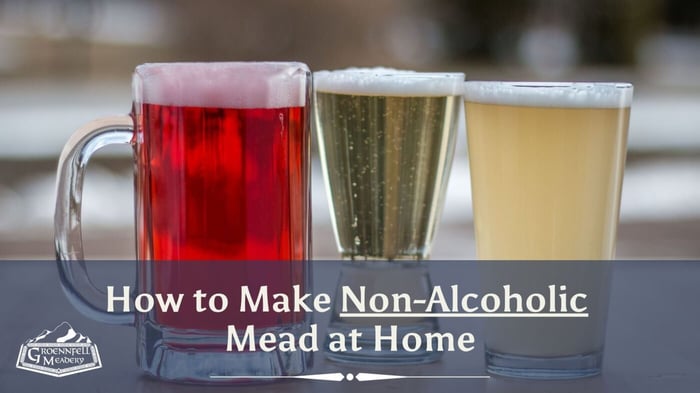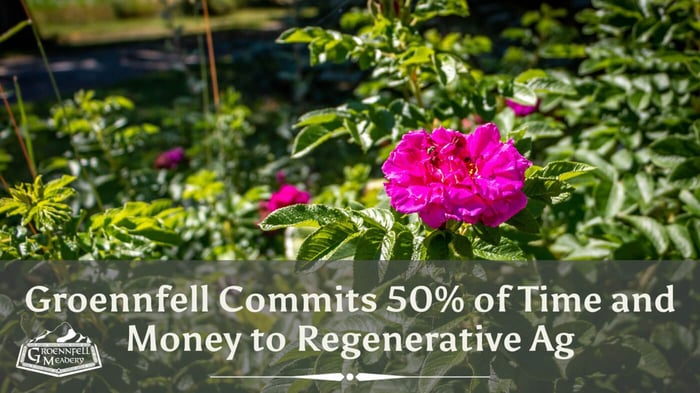We have a new Number One Most Asked Question: Is there such a thing as non-alcoholic mead?
We did a quick analysis and found that we've gotten this question 1.2 times per week for the last year (with peaks around the beginning of the New Year... hmmmm...).
Many folks might remember that Ricky made a 0% ABV mead for Kelly at the old Mead Hall when they were expecting Nora, so it must be possible, right?
(Pssst... If you want to jump right to some recipes, you can click here!)
Is there such a thing as non-alcoholic mead?
OK, first things first, if you believe that there's such a thing as n/a beer and n/a wine, then it naturally follows that there must be non-alcoholic mead, right? Well, yes and no.
Is grape juice non-alcoholic wine? Dentist, Minister, Staunch Methodist, and Durin I Impersonator Thomas Welch thought so. In fact, the product we now call Welch's Grape Juice was originally called "Dr. Welch's Unfermented Wine."
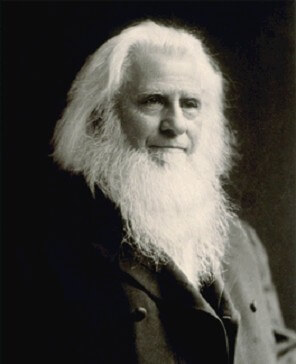
That said, 19th-century reformers aside, most of us would agree that fresh-pressed juice isn't non-alcoholic wine and unfermented wort isn't non-alcoholic beer.
To make non-alcoholic versions of intoxicating beverages, fermentation is usually run to completion, and then a mechanical extraction process removes the alcohol. This would imply that we could make mead, and then subject it to the same process. As far as we know, this has never been attempted and would be a waste of good mead, in our opinion.
So, yes, non-alcoholic mead could be manufactured using big fancy machines, but Ricky doesn't have big fancy machines, so is there another way?
An Important Aside About Small Beer
Throughout history, especially in African and European regions, there has been a beverage known by various monikers, but now generally classified as "small beers."
In Europe, they were grain-based, while in other regions they were made out of local fruit, such as the famous Banana Beer of Africa.
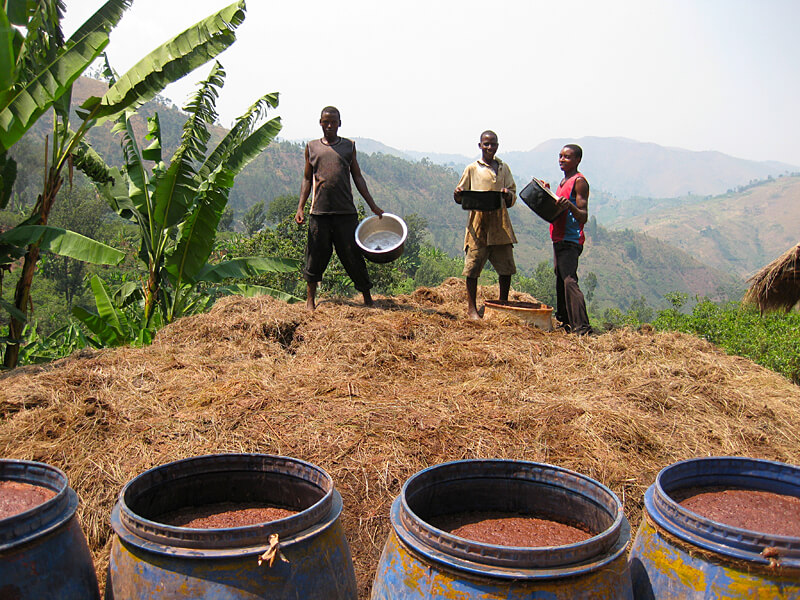
There's a discussion about exactly how low the alcohol content needs to be to classify something as a small beer. Ricky insists that at a mere 4.8%, Buckland qualifies, but tradition is against him on this one.
Small beers were historically considered safe for everyone, including children, and usually clocked in between .5% and 2.8% alcohol. Even in our modern era, Denmark has several Christmas beers with around 2% alcohol that are enjoyed by children on Christmas Eve (though, alas, under wider cultural pressure, this is falling out of practice).
So, following these rules, it would be very easy to make a 2.5% abv mead, a small mead, as it were. But, to be non-alcoholic mead by law, you would need to make...
Mead under 0.5% alcohol by volume
To fit the current EU and US definition of "non-alcoholic mead," you would need to produce a beverage that is under 0.5% abv when served.
As mentioned above, you could go through all the work of brewing a batch of mead, then send it through one of the modern contraptions that removes the alcohol.
Now, you might be thinking to yourself: I could brew mead and simply distill the alcohol out!
Well, you sure could! And what would be left would be just about the grossest thing you've ever tasted.
There's definitely not a large enough market for n/a mead to justify someone mass-producing it (which is probably a good sign for civilization), but there are plenty of good reasons why you might want n/a mead around the house!

How to Make Non-Alcoholic Mead at Home
Rather than focusing on beer and wine, let's switch over to Colonial America's favorite drink: Cider!
Essentially everyone in New England (and most of the US, probably) has had the experience of pulling a jug of fresh cider out of the fridge (or off the front porch, in the traditional fashion) and finding that the contents are a bit fizzy and not quite the cider you remember from the day before.
This cider is naturally fermenting and after a day or two will be carbonated but still under .5% alcohol. It will have a pleasant, tangy character, but won't knock you onto the backside of your knickerbockers. You can do the exact same thing with any liquid containing sugar, including a honey-water mixture! (Actual recipe below.)
Now, if you let that cider (or honey mixture) keep going, you'll end up with a full-blown hard cider around 5% abv. This is obviously not what we want. So, how do we keep our beverage low abv?
Borrowing a page from the home root beer kits, you have two options: kegs and plastic bottles.
For the keg method, you put your "mead" in the keg, stick it in the fridge, and carbonate as usual.
For the bottle method, divide your mead between several 1 or 2-liter plastic bottles. Leave them out on the counter in a warm, but not hot location. Squeeze the bottles every day. Once they're firm, pop them in the fridge! This will forestall any further fermentation.
Bingo! You've got non-alcoholic mead!
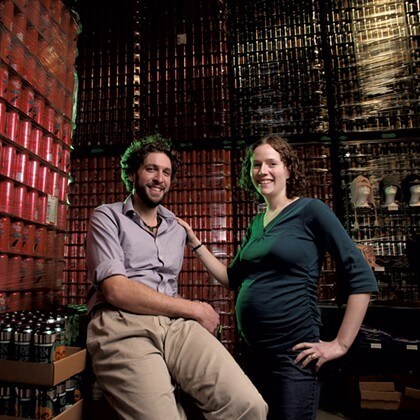
Non-Alcoholic Mead Recipe
For more non-alcoholic mead recipes and some ideas behind recipe design, head over here!
Basic Non-Alcoholic Mead Recipe
This recipe makes a one-gallon batch which fills five 1-liter bottles fairly nicely.
Ingredients
- 1 cup of honey (more to taste)
- 1 pinch of salt
- 1 cup fruit Juice (we really like V8 Blueberry Pomegranate)
- 1 tbsp lemon juice
- Enough warm water (about 102F) to bring the total to 1 gallon
- 1 packet bread yeast (or D47 Wine Yeast) [Only necessary if you're making it in bottles rather than kegs.]
Instructions
- Combine all of the ingredients except the yeast in a large bowl and stir until all of the ingredients are combined.
- Let it sit for 15 minutes.
- Stir again to confirm that everything is dissolved in solution.
- Sprinkle the yeast on top and wait 15 minutes. [If bottling rather than kegging.]
- Stir one more time, making sure the yeast is evenly distributed throughout the mixture. [If bottling rather than kegging.]
- Using a funnel, divide the mixture between the plastic bottles or pour it into your keg.
- If kegging, carbonate as usual.
- If bottling, leave the bottles out on the counter and squeeze them every day. As soon as they feel firm, pop them in the fridge. This step could take as little as one day or it might take a week depending on the temperature of your home.
- Allow the mixture to cool down to fridge temperature (at least overnight).
- Enjoy!

